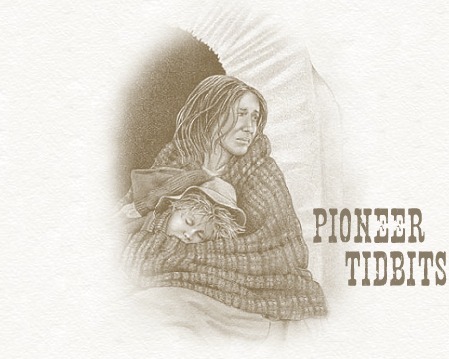1. The pioneers walked the Oregon Trail, but have you ever thought how many shoes were worn out by the time they reached Oregon?
According to the diary of May Ellen Murdock Compton, a 1853 emigrant, she started from Independence with ten brand new pairs of shoes and wore all of them out except the last pair. She saved this pair for the Oregon Country by walking barefoot over the last miles of her journey.
2. Some wagon trains painted their wagon canvas covers a bright red or blue. This way the individual wagons would know to which group of wagons they belonged.
3. Pioneers had what they called a "Roadside Telegraph." Pioneers would write messages on anything that was available to communicate with other wagon trains. "Anything available" meant cloth scraps, animal skulls, rocks, bark, leaves, etc. Some places were "Prairie Post Offices" meaning there were a number of messages that had been left at that spot for others.
4. 1852 was the "Year of the Bloomer," although few women emigrants wore this new fashion item. The bloomer offered a woman the chance to become more practical in regard to attire during their overland journey. Mariett Foster Cummings chose to wear bloomers to avoid the mud. Eliza Ann McAuley and her sister dressed in the height of fashion as they wore bloomers with light calf-skin top boots for wading through mud and sand. Most women preferred skirts.
5. It took roughly $800-$1,000 to obtain a proper outfit (wagon, food, clothing, etc.) and enough supplies to live a whole year without planting or harvesting a crop. Some families saved for three to five years before being able to begin their trip west.
6. The idiom, "Going off half-cocked," can be traced back to the safety device on most muzzleloader guns. In theory, the "half cocked" position on the gun would prevent the hammer from falling all the way, causing the gun to shoot. Obviously, this safety device did not always work.
7. Of the known deaths along the Oregon Trail, cholera was the leading cause. The present day state of Nebraska was the deadliest state for cholera. Ninety-six percent of all cholera deaths occurred by the time the emigrants reached South Pass. The disease "cholera" was first reported in the United States during the years of 1832-1834. St. Louis lost a tenth of its population to this disease. Many pioneers thought that by going west they might be able to escape this disease. But as one emigrant diary read, "The road from Independence to Fort Laramie is a grave-yard. "Another emigrant put the number of burials at 1,500 to 2,000 at this point on the trail, while yet another put the death total at around 5,000.
8. Toilet facilities were, for the most part, not mentioned in journals written along the Oregon Trail. But, according to emigrant Charlotte Pengra, one trail-side rest area looked more like a communal ditch. There are suggestions that the full skirts worn by most ladies acted as shields or "curtains of modesty" for this purpose. Obviously, bloomers would not provide this advantage.
9. Fine china was packed in barrels of flour and cornmeal. This packing technique was designed to prevent family heirlooms from being destroyed during the journey. In theory this was a great idea, but there was one serious drawback--usually, the travelers had to eat the flour and cornmeal during the trip, and most of the dishes ended up breaking anyway and had to be discarded along the trail.
10. It appears that one out of every five overland women were in some stage of pregnancy during the trip and virtually every married woman traveled with small children. This clearly illustrates the physical demands endured by women during their journey.
11. Women were considered young ladies when they reached the age of 13 or 14, and it was common for a 15 year old woman to be married. The average age for a woman to get married during the mid-1800's was 20, and the average age for men to be married was 25.
12. According to author John Faragher, "Children along the trail were pretty much allowed to shift for themselves, to grow as they might, with relatively little parental or maternal involvement in the process."
13. Portraits and photographs of dead family members, particularly infants and young children were highly cherished. This became a way of holding onto a life too soon snuffed out. In fact, in was not uncommon for a parent to pose with a dead infant in their arms and later place this picture on their mantle or table.
14. Over 60 percent of all male heads of households traveling the trail were farmers. Physicians, lawyers, teachers, and other professionals made up about 12 percent, while craftsmen and merchants made up about 20 percent.
15. In many wagon train groups, once every couple of weeks the women spent a full day doing the wash. As one emigrant woman wrote, "Camilia and I both burnt our arms very badly while washing. They were red and swollen and painful as though scalded with boiling water. I do not see that there is any way of preventing it, for everything has to be done in the wind and sun."



